

Foundry Dedication a Big Success
Founders Day Picnic, History Lectures to Celebrate 75th
Foundry Dedication a Big Success
Berkeley Lab’s Molecular Foundry — one of five proposed U.S. Department of Energy Nanoscale Science Research Centers and the only one on the West Coast — was officially dedicated on March 24. Remarkably, construction of this facility’s $85 million, six-story, 94,500 square-foot steel and glass building was completed barely two years after the ground-breaking.
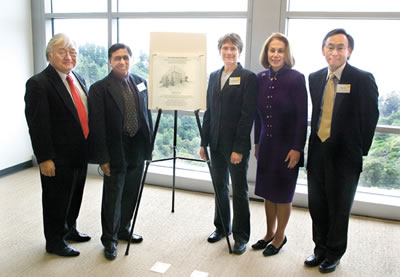
Above (from left to right) Honda, Carim, Bertozzi, McPeak, and Chu, and (right) the Molecular Foundry
“The Molecular Foundry has nanoscale research capabilities not found at any other facility,” said Foundry director Carolyn Bertozzi at the dedication ceremony. “It creates an environment in which scientists from different disciplines can work together under one roof to expand our knowledge of the nature of matter on a nanoscale.”
The dedication ceremony was held in the Foundry’s fifth floor Cantilever Room, which offers a spectacular view of the San Francisco Bay. On hand to help celebrate the occasion were Berkeley Lab Director Steve Chu and Associate Lab Director for Physical Science, Paul Alivisatos, who will head the Foundry’s inorganic nanostructures research program. Also presenting remarks were Sunne McPeak, Secretary for Business, Transportation and Housing for the State of California, Altaf Carim, from DOE’s Office of Science, and Congressman Mike Honda, who represents Silicon Valley and is one of the leading supporters of nanoresearch on Capitol Hill.
In her opening remarks, Bertozzi offered her highest praise and appreciation to Jim Krupnick and Joe Harkins, respectively the Molecular Foundry project director and project manager.
“Jim Krupnick kept us on schedule by knowing exactly when to crack the whip,” said Bertozzi. “Joe Harkins is simply a miracle of science. He understood every aspect of this building and everything that was needed to make its construction possible.”
The Molecular Foundry was designed by the SmithGroup of San Francisco and constructed by Rudolph and Sletten General Contractors, working in close collaboration with staff from Berkeley Lab’s Operations divisions, including Facilities, Environmental Health and Safety, Engineering and Information Technology Divisions, plus Procurement and Finance Offices, and other Lab groups. It is expected that the state-of-the art design and energy efficiency technologies used in the construction of the Molecular Foundry will result in its becoming the first Berkeley Lab building to receive a prestigious LEED Silver rating from the U.S. Green Building Council. Qualifying a research building for this rating is difficult because of the high-energy use such facilities typically incur. However, the Molecular Foundry is projected to consume 30-percent less energy than the already-stringent California requirement for laboratory buildings.
“This building is like a cauldron where we can take basic scientific information and make things happen that will enhance our lives,” said Congressman Honda, who was a co-sponsor of the 21st Century Nanotechnology Research and Development Act. In his remarks, he announced his sponsorship of new nano legislation aimed at helping research get to the commercial market.
In his welcoming remarks, Director Chu praised Daniel Chemla for having conceived of the idea for the Molecular Foundry back in 1991. At the time, Chemla said that such a facility would “change the paradigm for nanoscale materials research.” Chemla attended the dedication ceremony along with his wife, Berit.
To commemorate the dedication of the Foundry, a plaque, designed by Flavio Robles of the Lab’s Creative Services Office, was unveiled. The inscription on the plaque reads: “Dedicated this day, March 24, 2006, to serve the public good through the discovery, study and application of nanoscale materials, and the education of the next generations of scientists who will extend this work to dimensions unimagined today.”
Technology at the nanometer scale is not simply today’s micro-technology only smaller. At the nanoscale, which is one thousand times smaller than the microscale, matter exhibits very special properties because of quantum size effects, altered thermodynamics, and modified chemical reactivity. This presents special scientific challenges that the facilities at the Molecular Foundry are designed to meet.
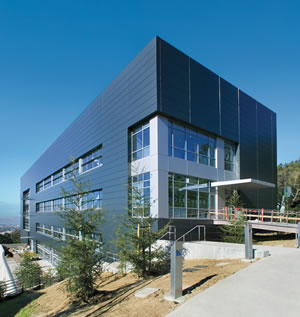
Research at Berkeley Lab’s Molecular Foundry will encompass “hard” (inorganic) materials, including nanocrystals, nanotubes, and lithographically patterned structures, and “soft” (organic and biologic) materials, such as polymers, DNA, proteins, and components of living cells. Nanometer lengths-of-scale are where investigations into hard and soft materials meet. To study this common ground, researchers at the Molecular Foundry will invoke the primary fabrication strategies of both the “top-down” approach practiced by solid-state physicists and physical chemists (in which existing structures and objects, such as semiconductors, are made smaller); and the “bottom-up” approach used by chemists and molecular biologists (whereby atoms and molecules are connected together to make larger structures and objects). The Molecular Foundry will host its own research program and collaborative programs with visiting researchers and will also provide training for graduate and post-doctoral students.
In addition to its research programs and training component, the Molecular Foundry will also serve its collaborators as a “portal” into three other national user facilities at Berkeley Lab: the Advanced Light Source, the National Center for Electron Microscopy, and the National Energy Research Scientific Computing Center.
Among the possible developments foreseen for the Molecular Foundry are the fabrication of electronic devices out of carbon nanotubes, the detection and treatment of diseases at the cellular level, the reduction of waste and pollution in manufacturing processes, improved sensors for real-time monitoring of chemical and biological activity, high-performance electricity transmission lines, and next-generation solar cells.
Founders Day Picnic, History Lectures to Celebrate 75th
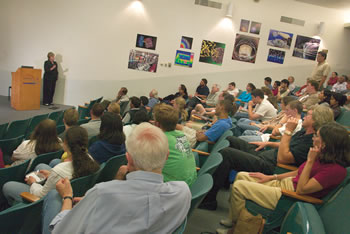
An old-fashioned picnic and barbecue for Berkeley Lab families and friends, featuring the burial of a time capsule and fun activities for all ages, will be the featured event honoring the 75th anniversary of the Laboratory. Built around a 1930s theme, the celebration will take place on Founders Day — Saturday, August 26, when Ernest O. Lawrence first received official authorization to establish his “Rad Lab” in 1931.
Also, a special edition of the annual Summer Lecture Series will feature reflections of the Lab’s distinguished past from some of its most prominent contributors. The lineup includes Nobel Laureate Donald Glaser, energy efficiency pioneer Art Rosenfeld, former Laboratory Director Andy Sessler, and long-time researchers Darleane Hoffman, Rich Muller, and Tom Budinger. All talks will take place at noon in the Building 50 Auditorium.
Volunteers are now being invited to participate in the planning and coordination of Founders Day. Employees are encouraged to bring their families, especially children, and their friends to the all-day event. Ex-Laboratory employees are especially welcome. Those interested in helping to put the program together should contact the Communications Department’s Lyn Hunter at Lhunter@lbl.gov.
At noon during the picnic, Laboratory Director Steve Chu will oversee the placement of a time capsule in the ground on the cafeteria lawn. It will be buried and sealed, with instructions to open it and view the contents at the 100th anniversary in 2031. Employees will be asked to suggest appropriate items to include in the capsule that reflect life and the Laboratory at the turn of the century.
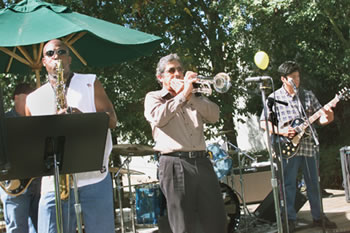
Here are some of the other things being planned for Founders Day:
- A special site tour of historic lab locations, via a motorized cable car
- Open laboratories and offices for employees to illustrate their workplace for friends and family
- Select facilities tours
- Hands-on science activities and carnival games for young children
- Employee Activities Association club events, including demonstrations and competition
- A “back to the ‘30s” costume theme, with prizes for the winning entries
- A classic car show, featuring vehicles from the ‘30s and ‘40s (employees are encouraged to bring their antique autos)
- Live bands and performers from the Lab, including a talent contest
- An arts and crafts fair
- Movies and newsreels from the 1930s in “Cinema 50” (50 Auditorium)
- Fitness programs
- A classic summer barbecue with hot dogs, hamburgers and veggie burgers
More will be unveiled in the coming weeks.
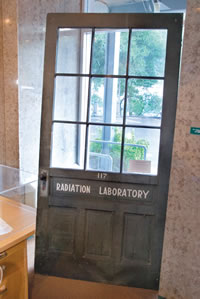
The 75th Anniversary Summer Lecture Series kicks off on Friday, June 30 with physicist Richard Muller reflecting upon the work he conducted with Nobel Laureate Luis Alvarez — “The Death of the Dinosaurs: 27 Years Later.”
Others in the series include: July 5, life scientist Tom Budinger, “Nuclear Medicine at Berkeley Lab: From Pioneering Beginnings to Today;” July 12, Nobel Laureate Donald Glaser, “Invention and History of the Bubble Chamber;” July 17, former physicist and energy specialist Arthur Rosenfeld, “Energy Efficient Buildings and Appliances: From Berkeley Lab to the Market-place;” July 26, physicist and former Laboratory Director Andy Sessler, “Seventy-Five Years of Particle Accelerators;” and Aug. 2, physicist Darleane Hoffman, “The Discovery of the Transuranic Elements.”
Additional anniversary events are being planned and will be announced soon.
Robin Lafever, A Model Citizen
Robin Lafever’s artworks are familiar around Berkeley Lab: spectacular images of the SNAP satellite, BaBar’s Silicon Vertex Tracker, the GRETINA gamma-ray detector, and a thousand other devices and exploded parts decorating Lab hallways and websites. Much as he loves drawings, however, his real love is 3-D models, the bigger the better.
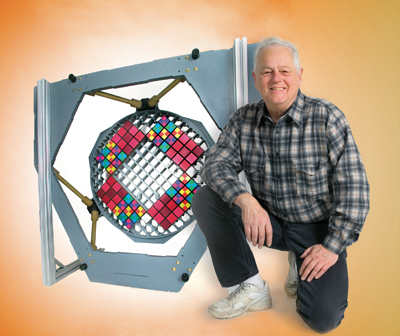
Lafever with the SNAP focal plane model
“The closer you can get to the real thing, the better the data,” Lafever says. A member of the Engineering Division, he often advocates building a full-scale model before completing engineering drawings.
The SNAP camera’s focal plane is a case in point. Mock-ups of SNAP’s unique CCDs and other electronics plug into the model support structure, allowing real cabling to be physically wrestled into place, “an area where CAD” (computer-aided design) “can’t help us,” he says.
Lafever developed his philosophy during what he calls “my first two careers.” At first he worked for an international architecture and engineering firm, building highways in places like the Nigerian bush and the mountains of Thailand. “Our speciality was to go into the boonies, hire the locals, and get to work.”
After he met his wife, Emy, in Bangkok, the two moved to San Francisco. She founded Guillermina Oriental Arts and Antiques and he started a series of small companies, meanwhile earning his degree in industrial design from San Francisco State. The invention of a rugged and versatile windmill generator made of nylon earned significant royalties and licensing fees for his first partnership.
Then came forensic work for legal clients, investigating fires. “We’d assemble a small team, build a full-scale reproduction, set it on fire, and see what happened.” He and his crew repeatedly burned copies of the restaurant where the fatal MGM Grand Hotel fire started in 1980. When an L1011 caught fire and crashed in Saudi Arabia, they built a 40-foot section from steel instead of aluminum so they could burn it more than once. “That’s when I learned how to start a fire in luggage with matchbooks in it, just by stomping in the right place.”
He learned that “a full scale model shows you what really happens; extrapolating from small models just creates extra work,” and that “small teams of sharp people can outrun any large company.” Speed was the watchword, 21 days from go-ahead to results, with everybody working “as long as we could without hurting ourselves.”
Lafever was building museum-quality replicas of sculptures for museums around the world the day “the Star Wars people asked me to build the power core of the Death Star — which they then blew to smithereens.” He now possesses the only remaining piece of the Death Star within several galaxies.
Lafever says he was already retired when he joined Berkeley Lab, but he’s hardly noticed the passing decade and a half. His enthusiasm for models has never waned; if he has his way, he’ll soon be building a full-scale model of the whole SNAP satellite.
“Rapid prototyping gets all the bad actors to come out early,” he says, and that’s not the only advantage. “Models are an unsurpassed communications and sales tool. The PR value, when you’re talking to the nontechnical people who have the money, can be worth the whole project.”
Snap shot: An inside look at one of the Labís many interesting employees
Bill Elkins
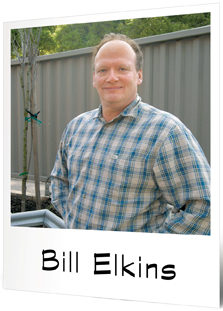
Name
Bill Elkins
Job
Manager, Labor & Employee Relations
Childhood Ambition
Pitcher for the Cincinnati Reds
Weirdest Job
Singer/musician for a rock band
Guilty Pleasure
Chocolate in any form
Hero
Bob Dylan
Proudest Moment
Holding my daughter Shannon when she was born
Last Book Read
Beyond Good and Evil (Friedrich Nietzsche)
Current Tunes on iPod or CD Player
The Mask and Mirror (Loreena McKennert), Avalon (Roxy Music)
Favorite Movie(s)
Once Upon A Time in America, Godfather Part II, Double Life of Veronique, Persona,
When Not Working
Watching films, sports, opera, working out, hiking
Ideal Vacation
A month touring Europe
Berkeley Lab Making a Difference:
Scientists Pave Way for Early Cancer Detection
A diagnostic test that exposes the first inkling of cancer in a cell’s nucleus could someday become a reality, thanks to a team of Berkeley Lab and Purdue University scientists who developed a way to automatically map the three-dimensional distribution of proteins within the nuclei of human mammary cells.
The technique, which couples state-of-the-art fluorescent imaging with computer-driven image analysis, could enable doctors to detect aggressive cancers in their earliest stages — giving physicians more time to fight the disease. It could also allow doctors to better characterize a patient’s cancer and match him or her with the most effective therapy.
“It won’t replace today’s tests, but it will give pathologists an important additional view of tissue,” says David Knowles, a scientist in Berkeley Lab’s Life Sciences Division who pioneered the system with Sophie Lelièvre, a former post-doc in Mina Bissell’s lab, who is a Distinguished Scientist in the Life Sciences Division. Lelièvre is now an assistant professor of Basic Medical Sciences at Purdue University.
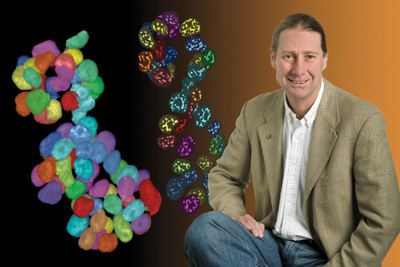
Knowles with fluorescent images of proteins found in breast cancer nuclei
Their technique hinges on the fact that inside a cell’s nucleus, proteins arrange themselves in a different pattern depending on whether the cell is malignant, hasn’t developed a specific function, or is perfectly healthy and mature. In the case of malignant cells, this telltale shift in protein distribution is believed to occur before the cells proliferate. It’s as if cells destined to become cancerous tip their hand to anyone clever enough to read it, which is where Knowles and Lelièvre come in.
First, they stained breast cell samples with a fluorescent substance that targets a protein, called NuMA, which is found in the nuclei of human mammary cells. When functioning properly, the protein helps regulate various aspects of the cells’ health. But when it malfunctions, the protein has been linked to leukemia and breast cancer.
Under confocal microscopy, the tissue samples appear as if they are painted with a large swath of luminescence, indicating the presence of thousands of nuclei and their NuMA proteins. Next, to pinpoint the spatial distribution of the proteins within each nucleus, they applied image analysis software developed by Knowles. The software automatically delineates the boundaries of each nucleus in a tissue sample, and then homes in on the brightest spots of luminescence within each nucleus — revealing the precise location of each protein.
A final step allows the scientists to map the distribution of the proteins by digitally unraveling the nuclei, starting from the outer edges and working toward their centers.
“We peel away the layers, like an onion, and quantify the proteins in each layer,” says Knowles.
Their analyses, which were conducted on tissue samples developed in the lab, reveal that the distribution of NuMA is very different in malignant cells compared to both differentiated cells, meaning they have become specialized for a particular function, and non-differentiated cells.
“In malignant cells, we find that the organization of the proteins is haphazard and completely disrupted,” says Knowles. “Whereas with the non-malignant cells, there is a real organization pattern, which changes as the cells differentiate.”
Knowles and Lelièvre can even see the difference between malignant cells and non-differentiated, non-malignant cells that proliferate, which means they can identify cancer-related characteristics that are very difficult or impossible to measure with usual cell biology techniques.
Although their technique is still in the early developmental stage, it could also contribute to the current thrust in breast cancer treatment, in which scientists are working to understand the different shades of cancer, and target each shade with specially tailored therapeutics. This method requires a degree of characterization that today’s techniques can’t always deliver. For example, pathologists currently examine potentially cancerous tissue samples using techniques such as Hematoxylin and Eosin staining. Although this workhorse test will likely be used for decades to come, it is a broad-brush tool that mainly captures changes in the shape and spatial distribution of cells and nuclei. If changes to smaller scale phenomena are captured, such as the distribution of individual proteins, then pathologists will able to better characterize cancer — and attack it with the best treatment.
“If we could play a role in this, we would be ecstatic,” says Knowles. “A pathologist could conduct our analysis automatically over a large population of cells, and map the results back onto the tissue. It would represent an entirely new platform on which they can base their decision.”
So far, Knowles and Lelièvre have only used the technique to explore how changes to one nuclear protein, NuMA, impact the malignancy of a cell. In the future, they’d like to broaden their inquiry by mapping a range of proteins, and determining if changes to their spatial distribution are also a hallmark of cancer. Ultimately, their technique may join the many tools physicians use to diagnose and characterize cancer, such as genetic tests, medical imaging, and Hematoxylin and Eosin staining.
“The end-goal is to combine these methods,” says Knowles. “Our technique could augment a pathologist’s report and shed a new light on how cancer is characterized.”
Their research is published in a recent issue of the Proceedings of the National Academy of Sciences. In addition to Knowles and Lelièvre, Carol Bator-Kelly of Purdue University and Berkeley Lab’s Damir Sudar and Mina Bissell contributed to the research.
Transferring Research to the Marketplace:
The Hows and Whys
Berkeley Lab researchers can still catch the last two installments of a four-part seminar series entitled: Transferring Technology to the Marketplace. Jointly sponsored by Berkeley Lab’s Technology Transfer Department and the Berkeley Lab Institute, in association with UC Berkeley’s Haas School of Business and College of Engineering, this seminar series was designed to “inspire and encourage” Berkeley Lab researchers to disclose their inventions, as well as to inform Lab scientists about the opportunities that tech transfer provides, and how they can become involved in the process. The series, which started April 5, has been playing to a full house at Perseverance Hall. All talks start at noon and run for about an hour. Employees are encouraged to bring a lunch.
The next talk in the series is scheduled for Tuesday, April 25 and is entitled: “What Are Licensees and Investors Looking For?” The guest speakers will be Anna Williamson of Genentech, Eric Fischer of Mobotec US, Inc. (a Berkeley Lab technology licensee), Michel Benard of Hewlett Packard, and Steve Visco, of Berkeley Lab’s Materials Sciences Division, an inventor who founded his own company, PolyPlus Battery.
The final talk in the series is scheduled for Monday, May 15, “A Conversation with Venture Capitalists,” features Milton Chang of Incubic Venture Fund, Shomit Ghose of Onset Ventures, Tom Baer of Arcturus Bioscience and Incubic Venture Fund, and Mark Modera, of Berkeley Lab’s Environmental Energy Technologies Division, and an inventor who founded Aeroseal, Inc.
For more information, contact Pam Seidenman, marketing manager for Berkeley Lab’s Technology Transfer Department.
Holding A Steady Course Through a Turbulent Decade
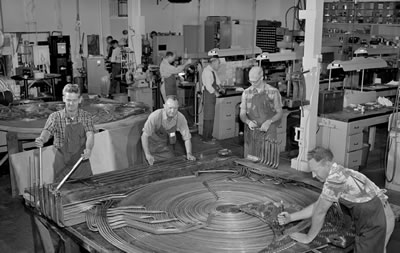
Technicians work on the magnet for the 88-inch cyclotron, 1960
Although Ernest Lawrence lay gravely ill in the Stanford University hospital on August 8, 1958, his 57th birthday, that didn’t keep him off the phone. When Elsie McMillan, wife of Edwin McMillan and sister of Lawrence’s wife Molly, dropped by to visit, he told her he’d spoken with Clark Kerr, president of the University of California, and asked him to appoint Ed McMillan deputy director of the Radiation Laboratory.
On August 27 Lawrence died. Three weeks later McMillan became director of the university’s newly renamed Lawrence Radiation Laboratory. McMillan, 51, had won the Nobel Prize with Glenn Seaborg in 1951 for creating the first transuranium elements, and he was the independent coinventor, with Soviet physicist Vladimir Veksler, of the principal of phase stability, which enabled generations of particle accelerators to exceed the limits of the cyclotron.
As gifted and inventive a scientist as he was, McMillan’s most distinguishing characteristic as the Rad Lab’s second director was judicious calm. Given what was coming in the 1960s, nothing was more important.
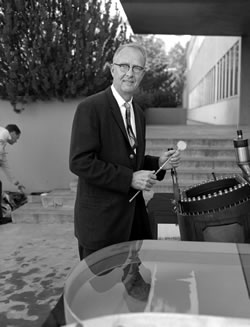
Luis Alvarez with his bubble chamber, 1968
The decade began serenely enough. When Nikita Khrushchev replaced Stalin as head of the Soviet Union in the mid ’50s, the Cold War, which had been getting hotter, began to cool off again. By September 1959 relations had improved to the point that Khrushchev could tour the United States, an outing marred only by his disappointment at not being able to visit Disneyland.
A year later, Khrushchev was banging his shoe on a desk at the United Nations and vowing to bury us. What went wrong? For one thing, a U2 flown by CIA pilot Francis Gary Powers had been shot down over Russia. It was the start of a decade of extraordinary social and political upheaval.
The first half of the ‘60s saw the Berlin wall, the Beatles, the Stones, Dr. No, a limited test ban treaty, Marilyn Monroe’s suicide, John Kennedy’s vow to land a man on the moon “before this decade is out,” and Martin Luther King’s “I have a dream.” The second half brought flower power, psychedelics, Joplin, Hendrix, Easy Rider, 2001: A Space Odyssey, Woodstock, and Neil Armstrong’s “giant leap for mankind.”
Kennedy’s assassination cast a pall over the entire decade. Afterwards came Vietnam, riots in Watts and Detroit, the King and Robert Kennedy assassinations, and the 1968 Democratic Convention in Chicago. Berkeley, always ahead of the curve, started its Free Speech Movement in 1964; a year before Kent State, tear gas, injuries, and one fatality marked the People’s Park demonstrations of 1969.
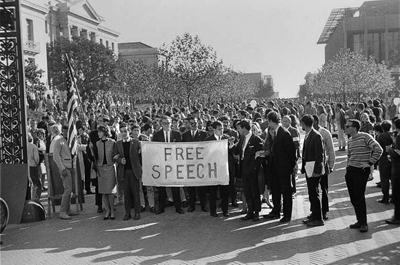
Students protest for free speech on the Berkeley campus
Meanwhile, Edwin McMillan presided over a Laboratory that collected Nobel Prizes by the fistful, made fundamental scientific discoveries, and underwent a growth spurt. More than 40 percent of the square footage Lab employees occupy today was built during McMillan’s tenure, including Bldg. 90, Bldg. 88 and its cyclotron, the 70A and 62 laboratories, the Calvin laboratory on the UC campus, and the 50A and 50B wings of the 50 complex.
Riding the Wave
The Rad Lab’s fame was at its height and its new director played host to a stream of visiting VIPs, among them John Kennedy, Prince Philip, Princess Margaret and Lord Snowden, and numerous distinguished foreign scientists (including Vladimir Veksler). The Queen of Greece insisted that McMillan drive her around in his white and teal-blue ‘57 Thunderbird, which he regarded as “the best car ever built.”
Although McMillan struck some on the Lab staff as remote, he had a dry sense of humor. In 1959 he loaned Emilio Segrè, who’d just won the Nobel Prize with Owen Chamberlain for their discovery of the antiproton, part of the formal wear he himself had worn in Stockholm in 1951. It became a tradition for every Lab Nobel Prize winner to borrow McMillan’s white vest — the only part of his rig that fit all sizes.
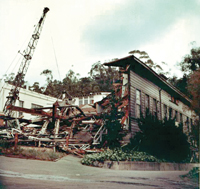
Demolition of the original Rad Lab on the campus, 1959
Almost all the Lab’s money in these years came from the Atomic Energy Commission. Because one of President Kennedy’s first acts was to name Glenn Seaborg Chairman of the AEC, McMillan was about as well connected in Washington as a Lab director could hope to be. To avoid conflict of interest, he resigned his post on the AEC’s General Advisory Committee; still, stories made the rounds, like the one about McMillan being in conference one day near the end of the fiscal year when his phone rang, with Seaborg on the other end: “We’ve got some funds left and the year’s almost up. How fast can you propose a building?” The result, supposedly, was Bldg. 70A.
The first part of Bldg. 72 was built in 1961 to house the Inorganic Materials Research Division under Leo Brewer, for studying the effects of the nuclear reactor environment on materials; it was the forerunner of today’s Materials Sciences Division. The Lab’s 88-inch “sector-focused” cyclotron was also part of the construction boom and produced its first beam in 1962. One newspaper article described it as “a mighty midget of the modern atom-smashing arsenal.” Bernard Harvey bulldogged the project and later became the first director of the Nuclear Science Division.
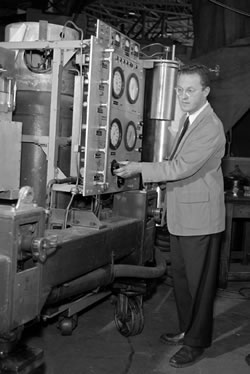
Donald Glaser with xenon bubble chamber, 1960
In 1961 Melvin Calvin (wearing McMillan’s vest) received the Nobel Prize in chemistry for research on carbon dioxide assimilation in plants. For years he’d studied photosynthesis in the original wooden Rad Lab building, which — decrepit as it was — had the advantage of lacking internal walls. When it was torn down in 1959, Calvin saw to it that it was replaced by a cylindrical “laboratory without walls.” Opened in 1963, the Laboratory of Chemical Biodynamics became the Melvin Calvin Laboratory when he retired.
McMillan presided over the continuing march of the heavy elements, which he himself had begun by creating neptunium in 1940. Albert Ghiorso, in charge of the HILAC (Heavy Ion Linear Accelerator), was now the parade marshal. Element 102 (later nobelium), created in 1958, and element 103 (later lawrencium), created in 1961, were separated from HILAC targets by chemical means; because of their short half-lives, team member Bob Costa became known as the “fastest chemist in the West.”
In particle physics, Luis Alvarez did spectacular work with a device he’d adapted after talking to a young postdoc, Don Glaser, at an American Physical Society meeting in 1954. Taking a leaf from Lawrence’s Big Science book, Alvarez evolved, through several stages, Glaser’s notion of a “bubble chamber” a couple of inches wide until it was a gigantic steel bathtub six feet long. Even Lawrence didn’t think the monster was practical, but he arranged a whopping $2.5 million AEC grant to Alvarez. The contraption began operating at the Bevatron in March, 1959.
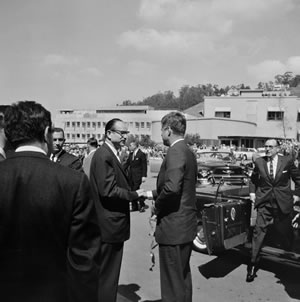
McMillan greets President John Kennedy during his visit to the Lab, 1962
The same year saw the successful use of spark-chamber detectors by Ed Lofgren’s group. Both kinds of detectors needed advanced methods of analyzing photographs. Denis Keefe and Leroy Kerth devised the spark chamber automatic scanning system, dubbed SASS. Millions of bubble chamber photos were analyzed using early computerized machines, the first of which was called “Franckenstein” after builder James Franck.
Among the numerous discoveries were mysterious “resonances” at certain energies, fleeting events that immediately decayed into combinations of other particles. All the key resonances but one were found at the Rad Lab by 1964, after which resonance hunters needed higher energies than the Bevatron could attain. Theorist Murray Gell-Mann fit them into a scheme called the “eightfold way,” which led him to propose the existence of quarks.
Glaser (wearing McMillan’s vest) got the Nobel Prize in physics in 1960 for inventing the bubble chamber, but Alvarez had to wait until 1968 to receive his Nobel Prize (while wearing McMillan’s vest) for “decisive contributions to elementary particle physics.” Meanwhile Glaser — who had been persuaded to come to the Rad Lab in 1959 by Glenn Seaborg, then chancellor of UC Berkeley — had gotten interested in biology; by 1965 he was building computerized systems to study bacterial colonies.
Let a Thousand Flowers Bloom
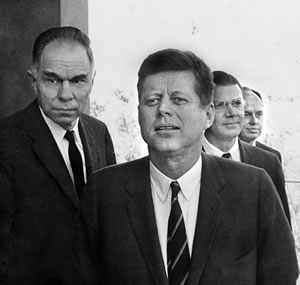
Kennedy with Seaborg (left) and McNamara (right) at the Lab
In 1965, chemist George Pimentel (who, like Calvin, gave his name to a prominent round building on campus) sparked a hydrogen chlorine explosion with a flashlamp and converted this chemical energy directly into laser light. The world’s first chemical laser was forerunner to the most powerful continuous lasers known.
Nuclear medicine continued to thrive under John Lawrence’s directorship of the Donner Laboratory, with imaging its fastest growing field. Hal Anger had invented the gamma ray camera in the 1950s and by 1960 was using scintillating crystals to form images with positrons as well; 1963 saw the first computed tomography scanners. Physicist and medical doctor Thomas Budinger joined the Rad Lab in 1965 and pushed the field into new terrain.
In December 1966 McMillan got his first bad news from the AEC. The site for the National Accelerator Laboratory (NAL) would be neither the Rad Lab nor Brookhaven, the “obvious” choices, but rural Illinois. Spearheaded by Robert Wilson, formerly one of Lawrence’s boys, NAL would become Fermilab.
The year 1966 saw the McMillans’ younger son spend a 12-month tour of duty in Vietnam, followed by a long, difficult recovery. At the Lab, opinions were divided over the war as strongly as in the country as a whole. Elsie McMillan recalled that her husband had to “subjugate his own political or antiwar feelings to act as an unprejudiced judge for the good of all.”
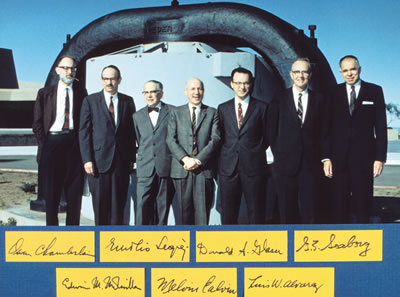
Seven Lab Nobel Laureates pose in front of Lawrence's 37-inch magnet, 1969 (from left to right) Chamberlain, McMillan, Segre, Calvin, Glaser, Alvarez, and Seaborg
Another proposed accelerator was lost, Al Ghiorso’s Omnitron, a collider that would have accelerated nuclei from hydrogen to uranium at a wide range of energies. Ghiorso blamed the cost of the war in Vietnam. He was inspired to create the SuperHILAC, finished in 1971, and proposed sending isotopes from it to the Bevatron, a tandem arrangement that would eventually become the Bevalac.
By 1969 Ghiorso’s team had developed new techniques to create and isolate element 104 (later rutherfordium); it was a time “when the first whiffs of tear gas met you coming down the hill,” recalled team member Kari Eskola. For weeks the streets of Berkeley were occupied by the National Guard during the People’s Park confrontation. Element 105 — subject of a bitter scientific dispute and still known as hahnium to its Berkeley Lab discoverers — followed in 1970.
In 1969 controversy erupted over using Lab facilities to host political speeches; for the first time, prior approval was required to use the Bldg. 50 auditorium. McMillan was relieved when the division of the Rad Lab that was located in Livermore, CA, established by Lawrence early in the 1950s and devoted to weapons research, was split off and made a separate laboratory in 1971.
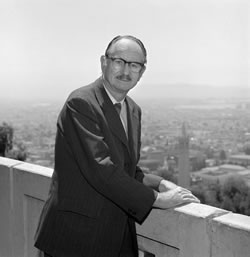
Director McMillan takes in one of the Lab's magnificent views on the Building 50 balcony
In 1968 accelerator physicist Andrew Sessler had “called for scientists at the Rad Lab to meet and discuss what could we do about the deterioration of the environment.” Despite widespread skepticism at the Lab, Sessler and nuclear chemist Jack Hollander had McMillan’s support; when 1970 court decisions forced the AEC to take responsibility for the environmental effects of hot water discharged from nuclear power plants, funds became available for an Environmental Research Office. From this beginning the Environ-mental Energy Technologies, Earth Sciences, and Accelerator and Fusion Research Divisions later descended.
McMillan’s tenure began at the end of the 1950s, when the Lawrence Radiation Laboratory was a “paradise of physics.” By November 1972, when he announced his intention to retire, he had witnessed many exotic flowers blooming in the cyclotroneers’ Garden of Eden. They included unanticipated advances in physics and nuclear chemistry and medicine as well as in materials sciences, physical biosciences, earth sciences, and environmental studies — an increasingly diverse approach to science emblematic of a new attitude at the Lab, and its new role in society.
Next: The Greening of the Rad Lab
Anatomy of a Construction Project:
The Foundry Story ó The Team That Built a Dream
This is a story about the people behind the science that gets accolades on the international stage. It is a story of perseverance, creativity, and skill. It is a tale of challenge and triumph, in 5 acts.
Act 1: Failing CD-Zero
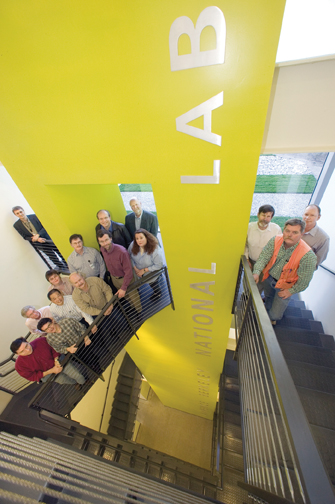
Members of the Molecular Foundry construction team in the stairway of the new building.
They called it a “Molecular Foundry,” and it was to be one of the world’s most advanced facilities for the study of a burgeoning field called “nanoscience.” A six-story edifice would be built to study things so small you can’t even see them with most microscopes. A grain of sand is a million nanometers in diameter. Materials pioneer Daniel Chemla pushed the concept of atom-by-atom design of new structures as early as the mid-90s, along with the need for technology and techniques to enter this new frontier of science.
The Department of Energy’s Pat Dehmer in Basic Energy Sciences liked the vision and put together the plan for five nanoscience centers across the complex, one of which would be sited at Berkeley Lab. A “critical decision” (CD) proposal was developed for this new Molecular Foundry in late 2001, and Lab personnel took it to Washington for a critical “Lehman Review” (Dan Lehman’s famous go-or-no-go project reviews). It failed.
“It didn’t have the right management model,” said Jim Krupnick, the Lab’s Director of Institutional Assurance. A long-time project manager who shepherded the Superbend and Howard Hughes Medical Institute beamline projects to their completions at the Advanced Light Source, Krupnick says he was at the airport with disappointed lab leaders that December when they asked him to take over the Foundry project. His charge: get a winning proposal together in five months.
Incorporating a reconfigured management plan, a new site, and a rare non-scientist (Krupnick) directing the whole thing, CD-1 was approved in May of 2002. Joe Harkins from Facilities was to be the project manager, and then-Foundry Director Paul Alivisatos would oversee the technical requirements.
Act 2: Plans and Protests
For the next year and a half, the action was procedural, tedious and intense. There was the matter of hiring an architect (the SmithGroup) to work up preliminary designs, and the contractor (Rudolph & Sletten) to start lining up subcontractors and develop schedules. On a parallel track, the legally required environmental review began, and later included a feisty meeting with community representatives and the Mayor of Berkeley in the Haas Clubhouse on campus. Harkins and Alivisatos found themselves verbally parrying with environmentalists concerned about native habitats, the watershed, and unhealthy nanoparticles in the air and water.
Harkins said some were convinced the Foundry would design the next generation of nuclear weapons.
The major players in Environment, Health and Safety at the Lab — John Seabury, Ron Pauer and their staffs — worked closely with the consultants to ensure a challenge-proof assessment and reasonable mitigations. At one point, the suspected presence of the endangered California whipsnake threatened to halt the project, but a biological survey found no habitat for the species. Six months after it began, the environmental review process concluded.
The side-hill location between Building 66 and the National Center for Electron Microscopy presented its own logistical challenges, calling for the expertise of Facilities staffers Steve Blair, Mike Dong, Fred Anglis, Larry Domansky, Rich McClure and John Musante to provide the engineering basis for the design.
Finally, with the planning milestones reached, the reviews successfully passed, and the legal requirements met, Harkins showed up on Lab Counsel Glenn Woods’ doorstep on Christmas Eve, 2003, when he signed the official notice to proceed with construction. The Foundry, on paper so far, was about to materialize.
Act 3: Slippage and Strikes
The construction crew noticed it as they were nearing completion of the retaining wall that formed the 75-foot-wide, 73-foot-deep hole that was prepared for the building — the wall was settling in the unanticipated soft soil. It had moved about four inches over three months. A shoring engineer was summoned, who suggested installing five or six “micropiles” to underpin the project.
“It cost a bit more, but the bigger risk was if the wall failed,” Krupnick recalled. “It was money well spent.” The retrofit wasn’t easy. “We had a system of air horns, so that if someone saw something blow at the dig, everyone could get out,” Harkins said. “We used it once, when someone noticed a crack (in the wall).” Except for a small cave-in at the face of the wall, all worked without incident.
That’s why you build in contingency to deal with “unforeseen circumstances” in the budget and the schedule, Krupnick noted. Another was the necessary rerouting of the sanitary line to avoid undocumented utilities that were found underground. Concrete slabs, gas lines, and electrical conduits surprised the excavators. The construction manager, Don Beaton, was instrumental in untangling this maze and finding right-of-way for these utilities.
Then there were the delays due to weather — about 10 days — and time lost when union workers honored the picket lines during three of the University of California’s labor contract protests. But each setback fit within the contingencies that Krupnick and company had built into the schedule. The early finish date of December 2005 probably wouldn’t be met, but they were still on course to meet the May 2006 milestone, and still within budget.
Act 4: Out of the Ground
“The big deal is getting out of the ground,” Harkins said. That landmark event took place in September 2004, when the foundation for a 95,000-square-foot super-science structure began to be laid — 2.3 years after CD-1. And what followed was a dramatic transformation that involved more than 1,000 different workers, most of them subcontracted labor, assisted by more than 100 people from Berkeley Lab.
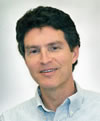
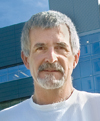
(L-R): Krupnick, Harkins.
One of those people, Sarah Eary, was especially critical. She interacted with scientists, the Department of Energy, and Lab procurement and finance representatives to ensure the right people and products were acquired for the job. Eary had to administer the subcontracts and navigate the rough waters of inflating material costs, most importantly structural steel in the fall of 2004, to keep the costs under control. Krupnick also cited Nick Peterson for his role in furniture specifications and acquisition, and fire marshall Gary Piermattei for adherence to safety requirements.
Speaking of safety, Krupnick said he was disappointed in the handful of minor injuries incurred by construction workers on the job. But the record suggests he shouldn’t be too hard on himself. No one was seriously hurt, and there were no injuries at all in the last eight months. Workers put in an estimated 450,000 hours on the job, and there was only one lost-time injury. His choice of Rudolph and Sletten as the managing contractor, at least partly based upon their positive safety record in prior experiences, proved to be prescient.
The Foundry project involved more than designing and constructing a building. It also included specification, procurement, and installation of more than $17 million of research equipment. That effort was coordinated by Jim Bustillo in Materials Sciences, working with Sue Walker-Lam from Procurement. According to Krupnick, Walker-Lam saved the project “hundreds of thousands of dollars” through deft negotiating techniques.
Sarah Morgan was a key contributor in many aspects of the construction phase of the Foundry project. She managed mountains of paper work, processed millions of dollars of payment requests, tracked hundreds of procurements to the penny and was instrumental in the successful completion of several DOE reviews.
Act 5: To Be Continued
As this dramatic new frontier plays out, the science that flows from the Molecular Foundry beginning this year will literally change the world. But as Berkeley Lab looks ahead to its next 75 years of achievements, it should pay its respects to the scores of people behind the science who make it all work.
Flutist Manages Medley of Emergency Operations Tasks for Laboratory
Her entrance into the world of emergency preparedness and management came as a fluke — or, more precisely — via a flute. As a professional flutist, Genevieve Pastor-Cohen, did not see herself as a Security and Emergency Operations Program Manager, the position she now holds at Berkeley Lab. But when a fellow trio member mentioned that he thought she would be perfect for a job opening in the California Governor’s Office of Emergency Services, she decided to give it a try.
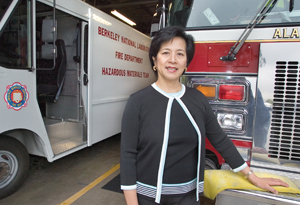
Pastor-Cohen of the Environment Health and Safety Division
That was 15 years ago. Now music helps her keep calm in a field that is wrought with disaster, literally. Pastor-Cohen joined Berkeley Lab as part of EH&S and Security in January. Now on the anniversary of the 2006 San Francisco 7.8 earthquake, Genevieve is spearheading the Lab’s involvement in Berkeley city and other regional efforts to simulate and prepare for an earthquake of similar magnitude.
“Being prepared minimizes your chances of being a victim,” she said.
Her goals for Berkeley Lab are to keep staff members and teams trained in emergency planning and awareness. Her charge is to ensure that every group at the Lab will be ready when “the big one” hits. That means practical things like up-to-date telephone trees, emergency checklists and procedures, survival kits, and business resumption plans.
Pastor-Cohen worked for the state’s Office of Emergency Services, Disaster Assistance Division and helped local governments recover and obtain grant funds after nine natural and man-made California disasters since 1992. She worked for a number of years as a sales representative for Eastman Kodak and fifteen years in the comprehensive emergency management field, before receiving her Masters of Science in Emergency Service Administration and her Certified Emergency Manager designation in 2005. She also worked as a hazard mitigation consultant after the North Ridge earthquake in 1994. Pastor-Cohen is excited to apply what she has learned in the private sector and local governments to a national laboratory.
She explained that comprehensive emergency management includes planning and preparing, prevention and mitigation, response and recovery. It also involves using common sense and being creative when the electrical and communications systems we depend on fail.
“What fascinates me is that you can do a lot with less,” she said. “You don’t need to buy fandangled technical equipment. You can look around and be creative to find things that can help you survive.”
She connects the creativity she finds in emergency management to the creativity and improvisation that she finds in music. Pastor-Cohen continues to play the flute in the Alameda Civic Light Opera’s summer musical productions and for the Holy Names Orchestra. She also plays in a number of musical groups at her temple.
“Music takes me to a different zone,”’ she said. “It makes me put everything behind me so that I can concentrate and perform professionally.”
City Honors Lab for Waste Reductions
It all started when former Lab employee and Berkeley City Councilman Gordon Wozniak was reading through the draft EIR for the demolition of the Bevatron.
“Included in the document are figures on how much waste the Lab has reduced over the last several years,” explains Community Relations manager Terry Powell. “Wozniak was quite impressed with this and felt we deserved a city proclamation as a result.”
The proclamation was presented on March 21 to David McGraw, Berkeley Lab’s Chief Operations Officer, for “its demonstrated leadership in waste reduction, setting an example that other nearby research laboratories and businesses might emulate to contribute to environmental sustainability in our communities, and for the aggressive and successful programs that contributed to meeting the U.S. and DOE waste reduction goals.”
These are the figures that wowed the city council and mayor Tom Bates: since 1993, the lab has reduced sanitary waste by 71 percent, hazardous waste by 78 percent, low-level radioactive waste by 74 percent, and mixed waste by a whopping 91 percent.
How did we do it? Increased awareness, the cost of disposal, and government mandates have resulted in researchers and other employees taking more interest in minimizing waste, says Nancy Rothermich, head of the Lab’s Waste Manage-ment program.
These efforts were aided by the implementation of the Environ-mental Management System, which brings together a team of representatives from across the Lab to develop ideas on how more reductions can be made in such areas as energy, water, and chemical use. Members propose projects, prioritize them, then select one or two to focus on each year.
Two examples include the use of digital imaging, which reduces the use of photo chemicals, and, the use of alternative fuel vehicles which reduces petroleum consumption, says Rothermich.
According to Powell, the city is also planning to issue proclamations for the Lab’s efforts to reduce energy use, educational outreach, fire-risk reduction, and scientific achievement.
People, Awards, and Honors
Physicist Receives Guggenheim Award

Haber
Berkeley Lab physicist Carl Haber is among the 187 artists, scholars, and scientists selected from almost 3,000 applications to be a Guggenheim Fellow. Guggenheim Fellows are appointed on the basis of distinguished achievement in the past and exceptional promise for future accomplishment. Haber was honored for his work in optical methods to recover sound from mechanical recordings.
Gourlay Named AFRD Director
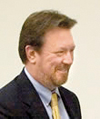 Gourlet
Gourlet
Berkeley Lab Director Steve Chu named Steve Gourlay director of the Accelerator and Fusion Research Division (AFRD). Gourlay, an AFRD scientist since 1997, has been acting director of the division since January, when Bill Barletta resigned after 12 years as AFRD director to head the U.S. Particle Accelerator School at Fermilab. Before becoming AFRD director, Gourlay was head of Berkeley Lab’s Superconducting Magnet Program and the magnet development component of the U.S. Large Hadron Collider Accelerator Research Program.
Associate Lab Director Member of Sirna Board
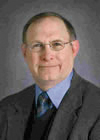 Gray
Gray
Sirna Therapeutics, a leading RNAi therapeutics company, has announced its Scientific Advisory Board (SAB), which includes Berkeley Lab Associate Director for Life and Environmental Sciences, Joe Gray. He is one of 11 world-renowned scientists who bring expertise in key areas that will help in transitioning Sirna’s pipeline programs from discovery to the clinic. Sirna is a clinical-stage biotechnology company developing therapies for serious diseases and conditions, including age-related macular degeneration (AMD), hepatitis B and C, dermatology, asthma, Huntington’s disease, diabetes and cancer.
Director Receives Duke Honorary Degree
 Chu
Chu
Duke University, located in Durham NC, will award four honorary degrees during its May 14 commencement ceremony. Among the recipients is Lab Director Steve Chu. Others include broadcast journalist Nina Totenberg and James Wyngaarden, former director of the National Institutes of Health.
Computing Project Gets 1.8 Million NASA Hours
 Day
Day
Members of Berkeley Lab’s Center for Computational Sciences and Engineering (CCSE) learned last week that their proposal to study “Interaction of Turbulence and Chemistry in Lean Premixed Combustion” was one of four projects selected to receive time on the 2,048-processor supercomputer “Columbia” at the NASA Ames Research Center. Marc Day is leader of the project. CCSE was awarded 1.8 million hours to “study the dynamics of ultra-lean, turbulent, pre-mixed burners incorporating detailed chemistry and transport for a variety of fuels.”
Berkeley Lab View
Published once a month by the Communications Department for the employees and retirees of Berkeley Lab.
Reid Edwards, Public Affairs Department head
Ron Kolb, Communications Department head
EDITOR
Pamela Patterson, 486-4045, pjpatterson@lbl.gov
Associate editor
Lyn Hunter, 486-4698
STAFF WRITERS
Dan Krotz, 486-4019
Paul Preuss, 486-6249
Lynn Yarris, 486-5375
CONTRIBUTING WRITERS
Jon Bashor, 486-5849
Allan Chen, 486-4210
David Gilbert, (925) 296-5643
DESIGN
Caitlin Youngquist, 486-4020
Creative Services Office
PHOTOGRAPHY
Roy Kaltschmidt, 486-5731
Creative Services Office
Berkeley Lab
Communications Department
MS 65, One Cyclotron Road, Berkeley CA 94720
(510) 486-5771
Fax: (510) 486-6641
Berkeley Lab is managed by the University of California for the U.S. Department of Energy.
Online Version
The full text and photographs of each edition of The View, as well as the Currents archive going back to 1994, are published online on the Berkeley Lab website under “Publications” in the A-Z Index. The site allows users to do searches of past articles.
Flea Market is now online at www.lbl.gov/fleamarket